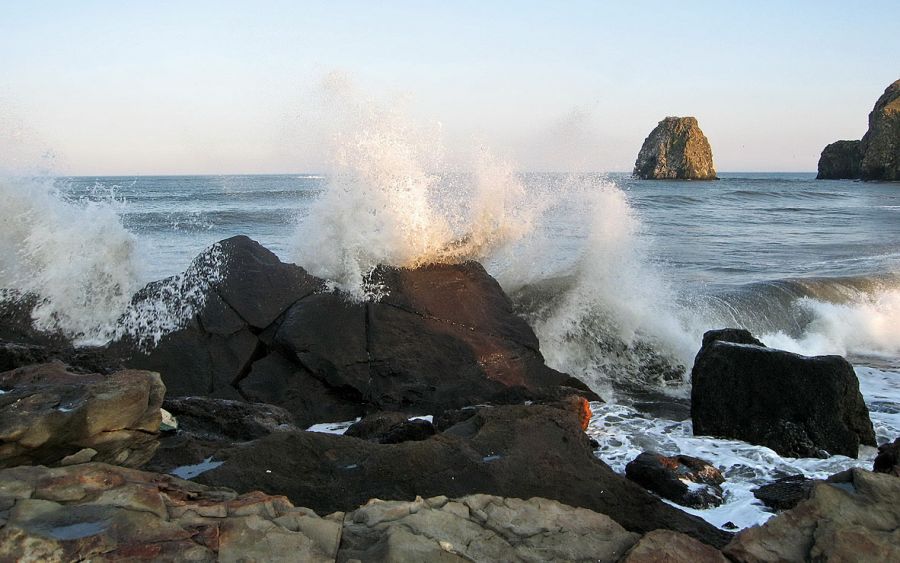RI0F Team will be active from Paramushir Island, IOTA AS - 204, Kuril Islands, Russia, 28 July - 3 August 2024.
Team - R7AA, RK8A, RM0F, RW3RN.
Recent DX Spots RI0F
RI0F Log search They will operate on HF Bands.
QSL via R7AA, ClubLog OQRS.
QTH Locator - QO80bq.
Previous activity:
RU0LM, UA0LCZ, RX3F, RK3AW, R6MG, R7MR will be active from Kuril Islands (IOTA AS-062) 16 - 26 June 2014 as RI0F.
They will be active on HF Bands.
QSL via RX3F.
 RI0F. Paramushir Island, Kuril Islands.
RI0F. Paramushir Island, Kuril Islands.
The Kuril Islands are a "harsh" and marvelous land
The Kurils stretch from north to south, from Kamchatka to Hokkaido Island, for 1200 kilometers between the Sea of Okhotsk in the west and the Pacific Ocean in the east. These are two chains of volcanic islands, about 55 in number, forming the Big and Small ranges of the Kurils. Territorially, the islands belong to Russia, being part of the Sakhalin Oblast, but the 4 southern islands, including the largest Iturup, are disputed by Japan, considering these lands as part of its northern possessions. The total area of the Kurils is more than 10,500 km2.
The islands are located at the junction of lithospheric plates, being part of the so-called volcanic ring of fire of the Pacific Ocean. Due to high seismic activity, this region is often shaken by earthquakes and its shores are attacked by devastating tsunamis. Of the more than 65 volcanoes, 36 are still active today, creating the islands' harsh lava landscape. The Kuril Islands are mountainous, and the highest point is Alaid volcano on Atlas Island (2,339 meters).

When gods ruled the world
The Kuril Islands have long been inhabited by numerous Ainu tribes who believed that these lands were once created by gods and later inhabited by humans. "Kuru" in the Ainu language means "man from nowhere." This is how they came to be called "Kurils", and soon the name was adopted for the entire archipelago.
In 1635, the Japanese explored the coastline of the Kurils and made a map, which was not accurate, as they did not dare to land on the islands. A decade later, during the expedition of Martin Fries, the Dutch came ashore and described these lands in more detail. After Vladimir Atlasov's expedition to the distant Kamchatka in 1697, the northern Kurils began to be talked about in Russia, and in 1711 a group of dashing Cossacks landed on the northern island of Shumshu, clashing with local tribes. By the end of the 18th century more than 2000 Kurils were brought into Russian subjection, and Catherine II exempted them from all taxes. At the same time the Japanese established two fortifications on Kunashir, making punitive operations deep into the island.
At the end of World War II, Russian troops occupied all the Kuril Islands, the southern part of which the Japanese still consider their territory today.

Against all winds
The climate of the Kurils is maritime and changes from arctic in the northern part of the archipelago to temperate in the more southern areas of Kunashir and Shikotan. Winters here are quite warm, while air masses from the mainland, bringing cold wind and snow, meet on their way the moist breath of the Pacific Ocean, which softens the climate of the islands. The average annual temperature in the south of the archipelago is +6-8 C°. In the northern part in July the thermometer reaches +11-13 C°.
The plant life of the Kurils is very diverse and varies depending on latitude. Northern Shumshu and Paramushir are mostly shrubs and small trees such as alder and rowan, as well as many herbs and berries such as blueberry, waterberry and lingonberry. Farther south, on Urup and Kunashir, the flora is more diverse: Sakhalin fir, Kuril larch and Ayan spruce neighbor with maples, oaks and hydrangeas. Rare magnolia, aralia, mountain peony and Kuril edelweiss can also be found here. In the middle part of the archipelago, Kuril bamboo grows on the islands, forming entire thickets on the slopes of volcanoes - an amazing sight!

Stubby bear and albatrosses
On Iturup one can still see the brown bear, which once inhabited almost the entire archipelago. There are also "cunning" foxes and small rodents. Gulls, petrels, falcons and giant albatrosses with a wingspan of up to 4 meters soar in the air. In order to preserve the natural riches of this region, a nature reserve was opened here back in 1984, where more than 80 species of rare animals have found their home.
The seas near the Kuril Islands abound with crabs, squid, fish and mollusks, which are exported in large quantities. Nimble seals, sea otters and predatory killer whales - formidable sea hunters - scurry in the water.
From edge to edge
Throughout the archipelago, the land is unevenly populated. About 20,000 people live mainly on the largest islands: Iturup, Kunashir, as well as Paramushir and Shikotan. The largest towns are Severo-Kurilsk and Kurilsk. The rest of the Kurils live in coastal villages.
Mineral deposits have been explored on the islands: non-ferrous metals (gold, silver), iron, mercury, titanium, as well as natural gas and oil deposits. However, the development and extraction of resources is poor due to the shortage of energy resources. To solve this problem, several power plants are planned to be built in the Kurils. The fishing industry is actively developing. Sea farms, where valuable fish species, which make up a large part of Kuril exports, are being revived.
The Kuril Islands are such a harsh and such a beautiful land!

